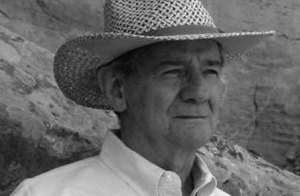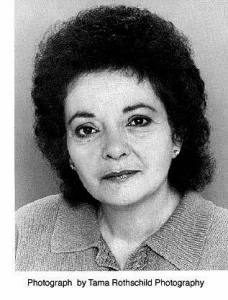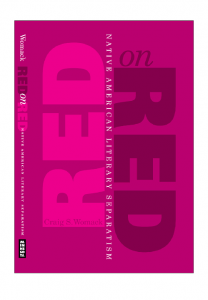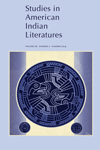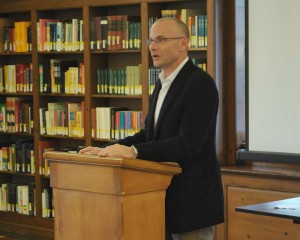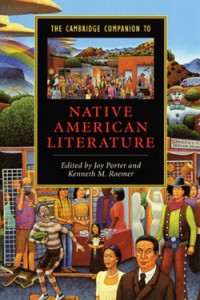Vizenor, Gerald. “The Ruins of Representation: Shadow Survivance and the Literature of Dominance.” American Indian Quarterly 17.1 (1993): 7-30. Web. 25 October 2014.
In reading Gerald Vizenor, it’s important to consider not what Vizenor is writing on the page, but rather what he is doing or demonstrating on the page. Vizenor is most well-known in his literary scholarship for the introduction of “trickster hermeneutics,” which he defines throughout multiple works, but also employs in his own works (hence the difficulty most readers experience with a Vizenor piece). Understanding Vizenor requires familiarity with his broader work, as his ideas are best understood through reading and connecting other ideas he has left, like clues, in various publications. To aid in my own understanding of Vizenor’s “The Ruins of Representation: Shadow Survivance and the Literature of Dominance,” I also had to read quite a bit about Vizenor’s life and scholarship, and one of the best companion sources I’ve found is David J. Carlson’s (professor of English at California State University) 2011 article “Trickster Hermeneutics and the Postindian Reader: Gerald Vizenor’s Constitutional Praxis.” Carlson’s article on Vizenor is particularly helpful because of the “Vizenorian Glossary” he offers to readers.
Using Carlson’s Vizenorian glossary and my own understanding of how Vizenor is using these terms in “The Ruins of Representation,” I provide an explanation of terms under each of the passages from Vizenor’s article, in order to understand the central purpose of “The Ruins of Representation.” However, I must point out that these definitions are not static definitions, for as Carlson explains in his work, the meanings of Vizenor’s terms change according to the piece at hand and even change within a piece, depending on the context of the paragraph or page.
In this particular work, Vizenor is ultimately presenting a defense for the use of postmodern theory in reading and studying NA materials, and really, is arguing that postmodernism is actually helpful to Native American writers and scholars who seek to claim and continue their survival and way of being in the academy and in the larger world. Vizenor opens his article by providing his basic argument of his article:
The postmodern turn in literature and cultural studies is an invitation to the ruins of representation; the invitation uncovers traces of tribal survivance, trickster discourse, and the remanence of intransitive shadows.” Furthermore, “the traces are shadows, shadows, shadows, the natural coherence of archshadows, visions, and memories in heard stories. The postmodern shadows counter paracolonial histories, dickered testimonies, simulations, and the banal essence of consumerism; at the same time, trickster pronouns, transformations, and the shimmers of tribal consciousness are heard in literature . (7)
To help readers understand this point a little more clearly:
Ruins of representation: the word “representation” refers to the postmodern term from Jean Baudrillard’s work Simulacra and Simulation, in which “representation” is not reality, but a representation of reality. Vizenor is implying then that postmodernism is a theory through which we can see through representations of the Native American, or see the ruins of representations of Native Americans.
Survivance: Carlson points out that Vizenor has defined survivance in his full-length work Manifest Manners, to mean “‘the right of succession or reversion of an estate, and in that sense, the estate of native survivancy’” (Carlson 16). However, Carlson also points out that Vizenor has intentionally used survivance in different contexts, with different connotations elsewhere. In this sense, we can perhaps understand Vizenor to mean that the application of postmodern theory to NA materials can help to uncover the return to a tribal understanding, or the return of power to NA communities.
Trickster discourse: this phrase also relates to Vizenor’s trickster hermeneutics; this is a discourse that is intentionally subversive and intentionally difficult to statically define. Trickster discourse also aids in or is a mechanism of the survival (physical and spiritual) of Native American communities and writers.
Traces and shadows: Throughout his article, Vizenor quotes and discusses the work of NA writers and scholars he admires, and who he believes captures the “traces” and “shadows” of “memories” and “visions” of “natural reason” (7), which he also relates to tribal consciousness.
Tribal Consciousness: as mentioned above, “natural reason” and tribal consciousness do relate to one another. As Carlson explains, “natural reason…is essentially form of dialectical thinking, the kind of thinking that Vizenor seems to believe characterizes traditional tribal consciousness and the trickster discourse that re-expresses it today. For Vizenor, the natural reason of tribal consciousness involves a rejection of the premises of formal logic” (Carlson 18). Tribal consciousness then, as Vizenor uses it in this context, postmodernity can help to reveal the evolving epistemology of Native Americans, through literature written by Native Americans.
Throughout the remainder of “The Ruins of Representation,” Vizenor defends and demonstrates the use of postmodern theory in NA literature, chiefly by weaving back and forth for the remainder of his essay in the following manner:
- defending and explaining postmodern scholarship through quoting a number of postmodern scholars, such as Linda Hutcheon and Jean-Francois Lyotard, and making obvious reference to Simulacra and Simulation;
- critiquing the social sciences (history, anthropology, and even NA literature) and particular scholars, such as Brian Swann and Arnold Krupat, for employing a structuralist approach in the study of NA materials;
- discussing and praising NA writers who represent true tribal consciousness, such as Luther Standing Bear, William Apess, N. Scott Momaday, Leslie Marmon Silko, Paula Gunn Allen, Elizabeth Cook-Lynn, Louis Owens, and A. LaVonne Brown Ruoff.
Though Vizenor’s work is difficult to understand and certainly can’t be read in a vacuum, he offers a compelling view of how postmodern theory can be appropriately applied to studying NA literature, particularly contemporary NA literature.
For more on Vizenor, see:
Carlson, David J. “Trickster Hermeneutics and the Postindian Reader: Gerald Vizenor’s Constitutional Praxis.” Studies in American Indian Literatures 2011: 13-47. JSTOR Journals. Web. 1 Nov. 2014.
